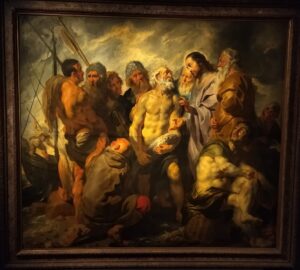Jacques Jordaens: The Calling of Peter
In Snijders&Rockox House, in the passageway between Washhouse and Kitchen (from St. James Church)
He [Andrew] first found his brother Simon [..]. He brought him to Jesus. Jesus looked at him, and said: “So you are Simon the son of John? You shall be called Cephas” (which means Peter) [or rock].
Look, look!
Let us look closely at this painting of Jordaens, as an exercise in viewing.
First of all, take a general glance at this scene, depicting the calling of the apostle Peter.
By looking at the centre of the composition, you ‘ll quickly notice that the two main characters are literally standing in the spotlight. Jesus, ‘the Light of the world’, is completely in the limelight, whereas Peter has only his bare chest accentuated.
The main key to understanding a lot of Baroque art is to think of it as ‘a classical theatre play’.
At a single location: the whole scene takes place at the Sea of Galilee (but we see real Flemish fishermen with their typical powerful heads).
At one point in time: it’s early morning, knowing that fishing is a night activity.
In one single action: follow the actors in their gestures; the open, inviting hands of Jesus in his beautiful robe; Peter’s hands, which for the time being, still hold on to his beautiful catch.
The meeting has been arranged by Peter’s brother Andreas, standing at the right. He is no longer wearing a fisherman’s outfit and awaits the outcome of this encounter, one hand at the side and the other in front of his waist.
The characters in the background are rather sketchy. They stand close together and hide the landscape, except for the lakeshore with the fishing boat at the extreme left of the picture.
It is not the effect of shadow and light, but it’s the composition that creates visual depth here.
The man kneeling on the left, and especially the seated figure on the right, drying a sock over a fire, are both placed in front (called repoussoir figures). The seated man is the actor with whom the audience is invited to identify themselves. It helps that both are portrayed ‘ad vivum’, in plain English ‘from life’.
Look at him first, then, together with him, watch the Peter-Jesus duo through his eyes. Now look at the Lord Jesus and his apostle and draw an imaginary line between their gazes.
For a clear understanding, we looked up the Bible text, about the first face-to-face between the two main characters. We found it in John, chapter 1, verses 41-42:
He [that is: Andrew] first found his brother Simon [..]. He brought him to Jesus. Jesus looked at him and said: “So you are Simon the son of John? You shall be called Cephas” (which means Peter) [or rock].
“Jesus looked at him and said”: don’t you think that this is precisely the strength of the painting: the visual dialogue, looking each other in the eye and being touched in the heart?
Imagine this work in a private room, above a chimney, so that you have you look up at it. In that setting you would completely grasp what perspective the painter is offering. Well, this painting was apparently intended for a carpet merchant, by the name of Michiel Wauters. It illustrates that Jordaens also supplied large-format paintings for well-to-do citizens.
Jacques painted this in 1616-1617 at the age of 23; he had been master in the Guild of Saint Luke then for one year only. You notice that in his early compositions he still struggles to break free from the traditional representation, in which heads are all at the same height. He has his characters lined up and does not show them in a perspective view.
Route North: opposite the SnijdersRockox House, go through the Ambtmanstraat to the Mutsaardstraat, on the little square in front of the Academy.

